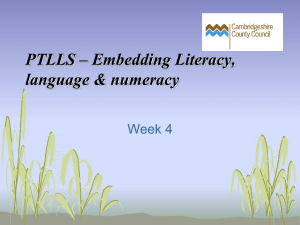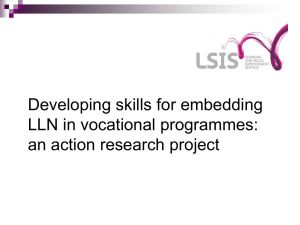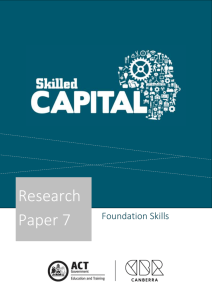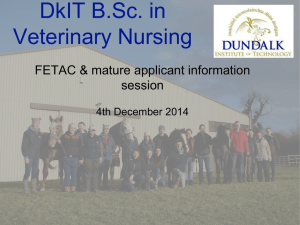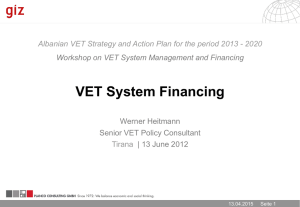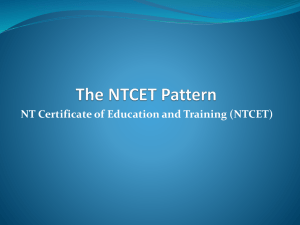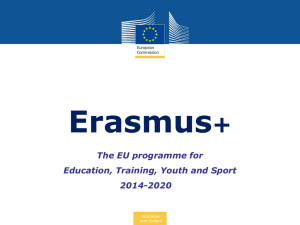Louise Wignal building VET capability
advertisement
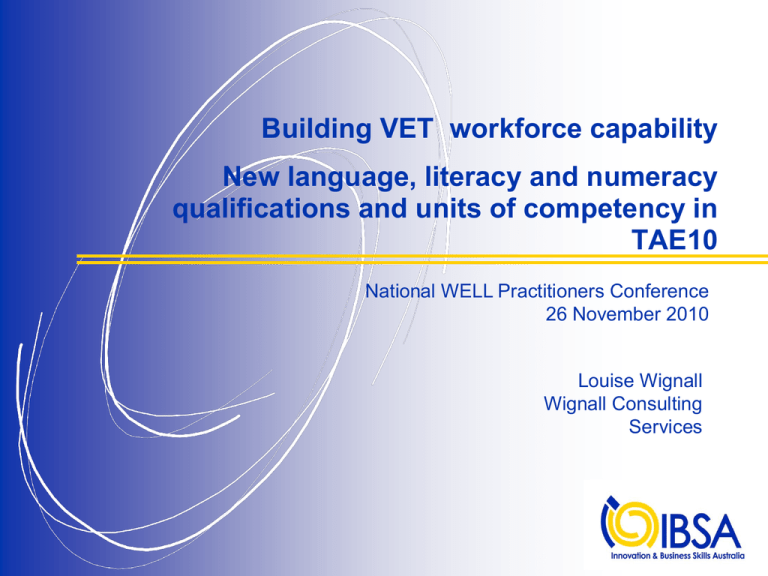
Building VET workforce capability New language, literacy and numeracy qualifications and units of competency in TAE10 National WELL Practitioners Conference 26 November 2010 Louise Wignall Wignall Consulting Services The issue for the VET and broader education sectors Foundation skills are underpinning skills for technical, generic, employability and learning to learn skills at all levels of the Australian Qualification Framework (AQF) (NVEAC paper). Part of all delivery, whether this is through Training Packages or through Adult Basic and General Education accredited courses. A number of key policy documents suggest the need for action – Adult Literacy and Lifeskills survey data (ABS, 2007) Skilling the Existing Workforce (AiG, 2008) COAG Skills and Workforce Development targets (COAG, 2009) Australian Workforce Futures (Skills Australia, 2010) Links Between Literacy and Numeracy Skills and Labour Market Outcomes (Productivity Commission report 2010). Part of a broader skills development plan Watch the broader policy space in 2011 with: Productivity Commission’s study of the VET workforce National regulation and quality arrangements for the VET sector and the establishment of the National Standards Council (NSC) for VET Research by the Australian College of Educators on behalf of DEEWR on the quality of teaching in VET Implementation of NVEAC Blueprint VET products for 21st C project outcomes DEEWR National strategy development. The need for a range of solutions More than 4 million employed people (40% of the total workforce) and 360,000 unemployed people (60% of the unemployed population) do not have sufficiently high literacy skills to meet the complex demands of everyday life and work. Yet only a small percentage of the population who require assistance with their LLN, in either the working or unemployed categories, will end up in specialised LLN skills development programs (such as the LLNP or WELL programme). Building VET workforce capability We need a set of options that suit: Volunteers ‘Frontline’ community services and health workers Workplace trainers and assessors operating in enterprises Vocational trainers and assessors operating in RTOs (public and private) training vocational ‘students’ Vocational trainers and assessors in RTOs (public and private) delivering TAE Cert IV quals VET practitioners wanting to specialise in LLN LLN specialists wanting professional development or a change in context of provision. Part of a broader skills development plan Current projects: Community Services and Health ISC national skill set for LLN volunteers and, a unit to be used in frontline worker qualifications e.g. welfare, housing, carer roles etc IBSA Building VET workforce capability project – to review best placement of LLN units in Cert IV and Diploma of TAE IBSA also investigating skill sets for workplace supervisors as part of Australian Industry Group LLN project. Respondents to the initial discussion paper Larger dual sector RTOs and public RTOs Infrastructure and resources to deal with LLN. In practice, support may be inconsistent Smaller public and private RTOs Limited internal capacity to support upskilling and learner needs. Other miscellaneous respondents LLN has inadequate organisational recognition. The broader system cannot support LLN needs. Initial findings from discussion paper Agreement that ‘LLN is an issue’ Different solutions needed for different ‘types’ of VET practitioners - one size will not suit all Agreement that practical solutions are needed for trainers with work expertise and industry knowledge but no LLN training Division of culture and understandings around LLN Supporting industry-based trainers The current Cert IV elective assumes an awareness of the impacts of LLN on learning and workplace competence – many would struggle with it. Regional and Industry-specific RTOs struggle to access LLN specialists. If the Certificate IV unit became available tomorrow, the sector does not have capacity to deliver. ‘The ‘big stick’ approach is counterproductive.’ ‘Mandating may not solve the issue. It may lead to ‘slapdash’ delivery!’ Supporting RTO-based trainers May have Cert IV and access to LLN specialists – but effective LLN skills provision is still hostage to a range of variables. LLN is addressed by ‘remediating’ – provision of LLN support, not as ‘skills building’ for all students as part of their VET course. LLN specialists are not invited to deliver the Cert IV elective by those responsible for delivery of the TAA/TAE Training Package – what would need to happen for LLN to become a whole of organisation commitment? ‘What are the skills around LLN issues in VET we would expect from the ‘experienced VET practitioner?’ How do we build professional development pathways from Cert IV? Expertise grows over time ‘Teaching and learning, including addressing literacy and numeracy skills, needs to be at the core of VET practice. As the Certificate IV can only be considered as an entry level qualification, VET professionals - VET practitioners continue to gain knowledge and understanding in teaching and learning as early career VET professionals. It is critical that they are supported with further training as their understanding of VET grows during this phase.’ Proposed solutions in Cert IV TAE Strengthen the references to LLN in core units (design delivery and assessment) Strengthen ‘critical aspects of evidence’ so that the issue must be dealt with in both delivery and assessment of TAE Cert IV Develop a ‘Guide to LLN within Cert IV TAE’ to make explicit the requirements and expectations at this level Develop an ‘awareness raising unit’ that outlines the impact of LLN on the learning process and on development of vocational and higher level communication and numeracy skills Develop a using the ACSF for skills gap analysis unit (as an elective) Diploma TAE- The place to build capacity of the experienced VET practitioner Include the Cert IV TAELLN401A as a core unit in the Diploma, or design a new ‘purpose built’ core unit for the Diploma, and Keep current Diploma unit TAALNN501A Support the development of Adult Language, Literacy and Numeracy Skills as a elective Include the Cert IV using the ACSF unit (as an elective) Over time (2-3 years) - increase number of VET practitioners who can deliver LLN unit content Vocational Graduate qualifications ‘We need an approach that enables more people who are able to deliver the LLN content of IBSA Packages before we mandate the elective’ We need more VET practitioners with a specialisation in LLN, who might come through: traditional education pathways VET training pathways Who are the new VGC & VGD qualifications for? Provide teaching and educational leadership skills for people working: in formal educational settings in the public or private sector (e.g. TAFE colleges, Private providers or ACE community houses), in informal education settings, social welfare and community-based settings (e.g. housing agencies, libraries, neighborhood houses, CFA fire sheds) in workplace settings (e.g. vocational/workplace trainers and assessors) and in correctional settings. Vocational Graduate Certificate in Adult LLN Practice Provides: credentials for existing language, literacy and numeracy teachers and trainers who may not have specific language, literacy and numeracy qualifications skills refreshers for existing language, literacy and numeracy teachers and trainers who may need specific skills for changing job requirements (such as an upgrade of numeracy skills or delivery to CALD learners) professional development for existing language, literacy and numeracy teachers and trainers who may want to shift their delivery practice from classroom to the workplace or vice versa upskilling for teachers wanting to move into literacy and numeracy teaching in VET from the schools sector an opportunity for teachers and trainers wanting to move from a vocational skill area into language, literacy and numeracy teaching to gain underpinning knowledge and skills effective strategies to support VET teachers and trainers who want to better integrate language, literacy and numeracy skill development into vocational training with their practice The Vocational Graduate Diploma of LLN Leadership Provides: credentials for existing language, literacy and numeracy teachers and trainers who are working as managers or learning leaders within their organisation who may not have specific adult language, literacy and numeracy qualifications professional development opportunities for existing language, literacy and numeracy teachers and trainers who may want to shift their emphasis from delivery practice to research or resource development professional development opportunities for teachers or trainers to develop skills in formulation of workplace or community based learning programs career pathway opportunities for policy makers, program coordinators, managers, HR managers, business consultants within a registered training organisation (RTO), social welfare practitioners, or educational design or learning and development professionals to develop their skills in adult language, literacy and numeracy Where are we at? Place of electives in Cert IV and Diploma currently under review Skill set projects underway VGC and VGD are endorsed and various RTOs are in the process of placing them on scope or mapping them to current existing qualifications for 2011 delivery - User Guide available on IBSA website IBSA to manage a DEEWR funded support materials project in 2011 Online RPL tool in development New rounds of DEEWR funded scholarships (for new practitioners) available (across 4 years) For more information Innovation and Business Skills Australia (IBSA) www.ibsa.org.au Click on ‘News and projects’ tab then pull down menu to : Current Projects Latest News To receive a copy of the ‘skills-set for supervisor paper’ please register your contact details with me now or in Support Materials and Online RPL tool workshop

